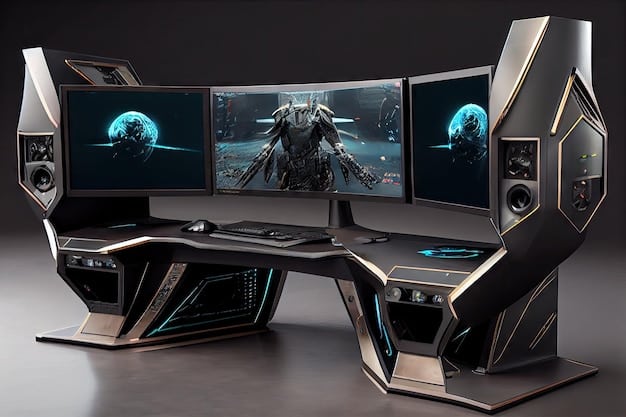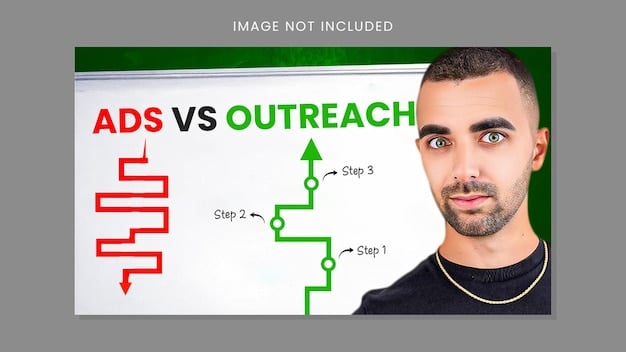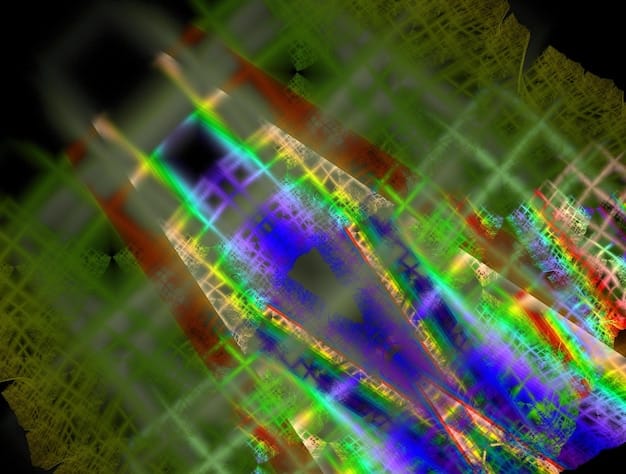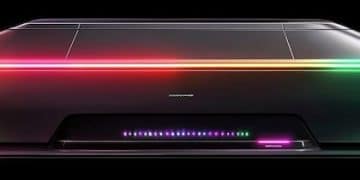Is Ray Tracing Worth the Performance Hit? Benchmarking 20 Top GPUs in 2025

In 2025, evaluating if ray tracing is worth the performance hit requires benchmarking 20 top GPUs to determine if the visual enhancements justify the reduced frame rates. This assessment will guide gamers in optimizing their gaming experiences.
Ray tracing has revolutionized gaming visuals, offering stunning realism through advanced lighting and reflection techniques. However, this graphical fidelity comes at a cost: a significant performance hit. As we look towards 2025, the question remains: is ray tracing worth the performance hit?
To answer this, we’ll benchmark 20 of the top GPUs slated for release in 2025, analyzing their ray tracing capabilities and performance trade-offs. This examination aims to provide gamers and enthusiasts with the information needed to make informed decisions about their next GPU upgrade.
Understanding Ray Tracing and Its Impact on Performance
Ray tracing simulates the way light interacts with objects in a scene, creating realistic reflections, shadows, and global illumination. While visually impressive, this process is computationally intensive, requiring significant GPU power.
The performance impact of ray tracing can vary depending on the game, the settings used, and the specific GPU. Older or less powerful GPUs may struggle to maintain playable frame rates with ray tracing enabled, while newer, high-end cards are better equipped to handle the workload.
The Basics of Ray Tracing Technology
Ray tracing works by tracing the path of light rays as they bounce around a scene. This allows for more accurate and realistic lighting effects compared to traditional rendering methods. The technology has evolved significantly since its introduction, with dedicated hardware acceleration becoming more common.
- Traditional rendering relies on rasterization, which approximates lighting.
- Ray tracing calculates each light ray’s path, creating accurate reflections and shadows.
- Hybrid approaches combine rasterization and ray tracing for optimized performance and visuals.

At its core, ray tracing enhances the visual experience by adding depth and realism. However, understanding the underlying technology helps in appreciating the performance trade-offs involved. In the next section, we’ll dive into which specific GPUs will be hitting the market in 2025.
Top 20 GPUs to Benchmark in 2025
Identifying the top GPUs for 2025 requires looking at the latest trends and rumors in the hardware industry. NVIDIA and AMD are expected to continue their rivalry, while Intel may also emerge as a significant player in the high-end GPU market.
Here are 20 GPUs that are likely to be contenders for the top spots in 2025, based on current industry expectations and technological advancements. These will be thoroughly benchmarked to determine is ray tracing worth the performance hit? for each card.
NVIDIA’s Potential Offerings
NVIDIA is expected to release its next-generation RTX series, potentially named the RTX 6000 or RTX 7000 series. Here are some anticipated models:
- NVIDIA RTX 6090/7090: The flagship cards, expected to offer the highest ray tracing performance.
- NVIDIA RTX 6080/7080: High-end cards providing a balance of performance and price.
- NVIDIA RTX 6070/7070: Mainstream cards capable of delivering good ray tracing experiences.
AMD’s Potential Offerings
AMD is likely to continue developing its Radeon RX series, challenging NVIDIA in various market segments. Expect the following:
- AMD Radeon RX 8900 XTX: The top-tier card, designed to compete with NVIDIA’s high-end offerings.
- AMD Radeon RX 8800 XT: A performance-focused card targeting the enthusiast market.
- AMD Radeon RX 8700 XT: A mid-range card providing excellent value for gamers.
It’s crucial to evaluate each of these GPUs to understand where they stand regarding ray tracing capabilities and overall performance. Next, we’ll discuss the methodology used for benchmarking these GPUs.
Benchmarking Methodology for Ray Tracing in 2025
To accurately assess the ray tracing performance of the top 20 GPUs in 2025, a rigorous and standardized benchmarking methodology is essential. This involves selecting representative games, defining appropriate settings, and using consistent testing procedures.
The goal is to provide a comprehensive overview of each GPU’s performance under different ray tracing loads, helping users determine is ray tracing worth the performance hit? for their specific needs.
Selecting Representative Games
The choice of games is crucial for benchmarking. Titles that heavily feature ray tracing and are known for their demanding graphical requirements should be included.
- Cyberpunk 2077: Known for its extensive ray tracing implementation.
- Control: Another visually stunning game with advanced ray tracing effects.
- Dying Light 2: Offers a mix of ray tracing and traditional rendering techniques.
Defining Appropriate Settings
Consistent settings are needed across all tested GPUs to ensure fair comparisons. This involves setting the resolution, graphics quality, and ray tracing level.
The resolution should include 1080p, 1440p, and 4K to cover different gaming scenarios. Ray tracing settings should range from low to ultra to assess performance scaling.
The benchmarking methodology must be transparent and replicable. In the following section, we will look at some of the performance metrics to be aware of.
Analyzing Performance Metrics: Frame Rates, Latency and More
When benchmarking GPUs, several key performance metrics need to be analyzed. Frame rates are the most obvious, but latency, power consumption, and thermal performance also play a significant role in the overall gaming experience.
Understanding these metrics is critical for determining is ray tracing worth the performance hit?, as they provide a holistic view of each GPU’s capabilities.
Frame Rates (FPS)
Frame rates, measured in frames per second (FPS), indicate the smoothness of the gameplay. Higher FPS values generally result in a more fluid and responsive experience.
With ray tracing enabled, frame rates often decrease. The goal is to find a balance where the visual benefits of ray tracing outweigh the performance cost.
- 60 FPS or higher is generally considered ideal for smooth gameplay.
- 45-60 FPS is playable but may exhibit occasional stuttering.
- Below 30 FPS is often considered unplayable for most gamers.
Latency
Latency, also known as input lag, refers to the delay between a player’s input and the corresponding action on screen. Lower latency values are crucial for competitive gaming.
Ray tracing can sometimes increase latency due to the additional processing overhead. Minimizing latency is essential for a responsive gaming experience.
Power consumption and thermal performance are also major details of interest when considering what new GPUs to purchase. We’ll look at the key factors to consider in the next section.
Power Consumption and Thermal Performance Considerations
In addition to raw performance metrics, power consumption and thermal performance are important factors to consider when evaluating GPUs. Higher power consumption can lead to increased electricity bills and the need for a more robust power supply. Higher temperatures can affect the lifespan of the GPU and require better cooling solutions.
These considerations are particularly relevant when assessing is ray tracing worth the performance hit?, as enabling ray tracing can significantly increase power consumption and heat output.
Monitoring Power Consumption
Power consumption is typically measured in watts (W). GPUs with higher power consumption ratings require more power from the PSU and may generate more heat.
Monitoring power consumption during benchmarking helps determine the efficiency of each GPU under different workloads. Lower power consumption for similar performance is generally desirable.

Assessing Thermal Performance
Thermal performance refers to the ability of the GPU to dissipate heat. High temperatures can lead to thermal throttling, where the GPU reduces its clock speeds to prevent damage.
- Effective cooling solutions are essential for maintaining optimal GPU performance
- Liquid cooling usually provides better thermal performance but at a higher cost.
- Ambient temperatures influence thermal performance.
| Key Element | Brief Description |
|---|---|
| 💡 Ray Tracing | Advanced lighting needing powerful GPUs. |
| 📊 Benchmarking | Testing GPUs to see if ray tracing affects gaming. |
| ⚡ Top GPUs 2025 | NVIDIA & AMD compete for the best. |
| 🌡️ Thermal Performance | Heat affects GPUs, so cooling is essential. |
Frequently Asked Questions
Ray tracing is an advanced rendering technique that simulates light for realistic graphics. Enabling ray tracing enhances visuals but may reduce frame rates, affecting gameplay smoothness.
Benchmarking helps evaluate GPU performance under different conditions. It ensures that you get the most out of new PC parts and games.
NVIDIA’s RTX 7000 series and AMD’s Radeon RX 8000 series are anticipated to be leading contenders in 2025, excelling in ray tracing and overall performance.
High temperatures can shorten the lifespan of a GPU. Effective cooling solutions are crucial for maintaining optimal performance and preventing thermal throttling.
Potentially, this may happen. The answer will impact gamers, guiding upgrade investments based on preferred use of top tier gaming tech.
Conclusion
As we approach 2025, the question of is ray tracing worth the performance hit? remains a crucial consideration for gamers. Benchmarking the top 20 GPUs will provide valuable insights into their ray tracing capabilities and overall performance.
By analyzing frame rates, latency, power consumption, and thermal performance, gamers can make informed decisions about their next GPU upgrade. Ultimately, the choice depends on individual preferences and priorities, balancing visual fidelity with smooth gameplay.





